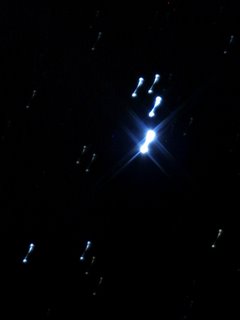First clear night for ages! Got outside at 6.30 to see what I could see, I've had a bad back all week so the Skywatcher had to miss out.
First I sat in a deck chair with the Monocular waiting for my eyes to adapt to the dark. Then I tried (again) to see M81 and M82, nothing at all! Out came the MM2 but still nothing, so decided to test the scope on Mizar, the MM2 easily splits the double but not the double double of this famous quartet.
Mizar (the second star in the handle of the big dipper) and its companion are 4 seconds of Arc apart and is a good test for any newcomer with Bin's or small scope.
Next I took a look at Lyra, Vega shining brightly and viewed each of Lyras components, the double double is merely a double with the MM2. Tried to see M57 but not a hope through the spotting scope.
Got a tad confused over Beta Lyra, which through the scope was a double with a blue/white coloured star, lovely to look at. But my book just described it as an "eclipsing variable", not a double so I thought I was looking at the wrong star. According to web sources an eclipsing variable double means the stars are so close that we only know the star is a double by observing changes in luminosity over time. So I'm none the wiser at the minute as to what I was looking at!
A quick look at Albireo was due, as always an excellent sight, looked for M56 half way between Albireo and Beta Lyra, think I found it but not impressive through the MM2 due to its lack of aperture.
Brochi's cluster was nice to see, it just fills the view at the MM2s lowest mag (15x).
Then a quick look to see if I could still find M31, easy once you know where to look! Still just a fuzzy blob though, at least I now know that it stills looks like a fuzzy blob even through a 14" Dobsonian thanks to the astronomy groups last meeting.
The Pleiades look as stunning as ever even through the small aperture.
Later
Mitch









